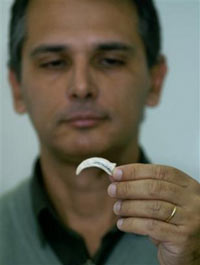Scientists show dinosaur fingernail fossil
(AP)
Updated: 2006-05-20 09:09
A dinosaur claw fossil found in Brazil reinforces the
theory of an evolutionary link between dinosaurs and birds, a new study says.
Brazilian scientists dubbed the dinosaur the dino-bird, which they said was
found in Minas Gerais state, about 370 miles northwest of Rio.

A
fossilized finger-nail from a Maniraptoran dinosaur, found in Uberaba,
Minas Gerais, 560 miles from Rio, is shown by geologist Ismar de Souza
Carvalho, at the Federal University of Rio de Janeiro (UFRJ), in Rio de
Janeiro, Brazil, Thursday, May 18, 2006. Ismar de Souza Carvalho says the
Maniraptoran dinosaur is a significant find because it proves the
transition of dinosaurs into birds.[AP Photo] |
Ismar de Souza Carvalho, who co-authored the study, said Thursday that it
likely belonged to an unknown group of dinosaurs who walked the Earth some 70
million years ago.
"The anatomic structure of this claw shows, quite possibly, the link between
carnivore dinosaurs and birds that exist today," said Carvalho, a member of the
Paleontological Investigation Center at Minas Gerais state university.
One expert not involved in the study said that while the theory of a link
between dinosaurs and birds has gained acceptance, he expressed doubt that a
claw fragment could prove the existence of a previously unknown dinosaur.
"If this claw was all that was found, then it would be rather extravagant to
create an elaborate theory based upon it. This claw doesn't add particularly
much to our knowledge of the origins of birds, but it does show that raptor
dinosaurs were present in Brazil toward the end of the age of dinosaurs," Thomas
R. Holtz, Jr., a vertebrate paleontologist at the University of Maryland, said
Friday.
"The claw is similar in shape to that of many other raptors, such as
velociraptors. But from there we can't infer it is likely a similar dinosaur."
The Brazilian findings were published in the magazine of the Argentine
Natural Science Museum.
|